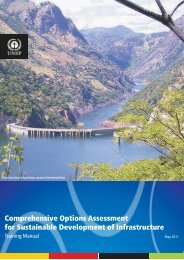MEASURING WATER USE IN A GREEN ECONOMY - UNEP
MEASURING WATER USE IN A GREEN ECONOMY - UNEP
MEASURING WATER USE IN A GREEN ECONOMY - UNEP
Create successful ePaper yourself
Turn your PDF publications into a flip-book with our unique Google optimized e-Paper software.
Measuring water use in a green economy<br />
Figure 2.5<br />
Singapore GDP, population and total water consumption, 1965–2007 (index, 1965 =1)<br />
30<br />
25<br />
GDP grow 26 times<br />
Total Consumption (mgdy)<br />
Population (’000)<br />
20<br />
15<br />
10<br />
5<br />
Consumption grew 5 times<br />
GDP (S$ millions)<br />
0<br />
Population grew 2.5 times<br />
GDP Index<br />
Consumption Index<br />
Population Index Source: Khoo (2008)<br />
consistently for the last 15 years providing an exception to an otherwise worldwide increase. This<br />
result is no accident. The Singapore government is one of the few with a publically stated target<br />
for residential sector per capita water use of 140 litres per capita per day by 2030.<br />
Singapore and its Public Utilities Board have also reduced growth in water consumption<br />
by minimising water leakage throughout the city’s water infrastructure which is tracked by<br />
measuring the level of ‘unaccounted for water (UFW)’ (Tortajada, 2006b). This has been<br />
reduced from 9.5 per cent of total water production in 1990 (Khoo, 2005) to 5 per cent by<br />
2002. This is a level that no other country can match at present and contrasts with the fact that<br />
unaccounted for water in most Asian urban centres now ranges between 40 and 60 per cent.<br />
Singapore has also reduced absolute freshwater consumption by 60 per cent through the<br />
development of alternative sources such as extensive stormwater harvesting, treatment and reuse,<br />
treated and recycled municipal water, and desalination. Today, 35 per cent of Singapore’s water<br />
comes from rainfall captured on its own limited territory, about 15 per cent is high-quality<br />
recycled water produced from wastewater by its ‘NEWater’ treatment plants, 10 per cent comes<br />
from desalinated water, and around 40 per cent is imported from Malaysia (ADB, 2005).<br />
In 2010, the Singapore government and its Public Utilities Board announced that it has now<br />
committed to replacing the final 40 per cent of imported freshwater usage with further waterefficiency<br />
improvements as well as the development of greater levels of water recycling and<br />
desalination so as to eliminate the need for imports from Malaysia by 2060.<br />
This remarkably integrated and holistic approach to sustainable urban water management has<br />
been institutionally possible because Singapore’s Public Utilities Board currently manages the<br />
entire water cycle of Singapore, as well as electricity and gas. This includes sewerage, protection<br />
and expansion of water sources, stormwater management, desalination, demand management,<br />
pricing, community-driven programmes, catchment management, and public education and<br />
awareness programmes, leading to wastewater treatment and reuse on an unprecedented scale.<br />
25

















